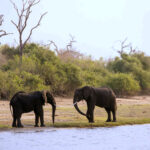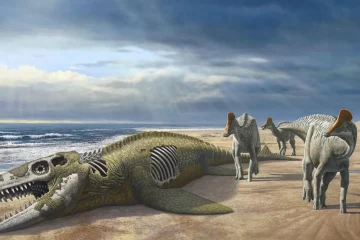RESEARCHERS in South Africa have unearthed groundbreaking evidence that sheds light on the ancient communication methods of elephants, according to an academic report quoted in The Conversation.
A research team led by Charles Helm of the African Centre for Coastal Palaescience at Nelson Mandela University in South Africa published a report in ScienceDirect, a scientific research journal, in September 2023.
The team’s work focused on the discovery of 35 fossilized elephant track sites, some of which are the first-ever trunk-drag impressions.
“These have been noted in South African Pleistocene coastal deposits, in apparent association with elephant tracks,” the scholars explain in their research paper, published in September 2023.
The report introduces the concept of seismic waves, describing how earth vibrations, caused by movements or rumbles from elephants, can travel beneath the surface for up to 6km, enabling elephant groups to interact across substantial distances.
The research marks a significant stride in the ongoing quest to decipher the intricate communication modes of these colossal creatures, according to The Conversation.
Helm, quoted in a review of this discovery in The Conversation, emphasizes the importance of this breakthrough.
He highlights that over the past 15 years, his team has identified more than 350 track fossils of various vertebrates along South Africa’s Cape South coast.
“Elephants, like another group of massive land creatures, dinosaurs, can be viewed as geological engineers that create minor earth-moving forces on the ground they walk(ed) on,” he explained.
This seismic communication, as noted by phys.org, is not exclusive to elephants; it has been observed in small animals, insects, and even elephant seals.
While different researchers have in recent years attempted to offer evidence-based explanations for these complex communications, the South African discovery stands out as the most consequential.
Helm explained how in 2019, the research team first discovered a cluster of fossil elephant tracks that was a round feature, 57cm in diameter, containing concentric ring features off the coastline of De Hoop Nature Reserve, about 200km east of Cape Town.
A second discovery was made in the same year, less than 2 meters away from the initial site, and was exposed about 7cm below the surface. It contained at least 14 parallel groove features that were approaching the rings.
“We hypothesized that they were connected with each other and appeared to have a common origin,” Helm shared in the article.
“We postulate that vibrations from rumbling travelled down the elephant limb and created the concentric ring features,” he added.
This discovery opens up the fine details of the world of elephants, the largest living land mammals that are not only complex in stature but also in their unique cognitive abilities.
Justus Arisi, a Kenyan tour and travel entrepreneur, views this latest discovery as a confirmation of the complex communication system in elephants.
“I have observed that their communication system involves a range of vocalizations, body language, and even read of their use of seismic vibrations that travel through the ground… They maintain strong social bonds and engage in cooperative behaviours such as caring for injured others,” he explains.
Research on elephant seismicity is on the rise, with scholars from across the world considering the African elephant for their study. The African elephant is the largest elephant species existing globally.
At Mpala Research Centre, a Kenya-based cattle ranch and wildlife area in Laikipia County, researchers are now investigating how and why elephants communicate via seismic vibrations. Past studies have also been undertaken in Namibia’s Etosha National Park.
To ensure the continuity of research on elephant seismicity, Helm stressed the importance of integrating three bodies of knowledge: research on existing elephant populations, ancestral knowledge often depicted in rock art, and the trace fossil record.
The new findings come at a time when elephant numbers are rapidly declining. According to the African Elephant Status Report by the Elephants Protection Initiative Foundation, Africa is currently home to about 415,000 elephants—a stark drop from over 1.3 million in 1979.
Disturbingly, recent reports from Tanzania highlight the killing of two super tuskers with tusks weighing at least 100 pounds by trophy hunters in the West Kilimanjaro area, further underscoring this underlying urgency for conservation.
Africa Geographic reports that two suspected hunting companies are responsible for the killing and burning of elephant carcasses, indicating the ongoing threats faced by these majestic animals.
Despite these challenges, some African countries are taking proactive measures to counter the illegal wildlife trade. Nigeria, for instance, recently crushed over US$11.2 million worth of ivory, joining efforts with countries like Kenya, South Africa, and Gabon to implement stringent measures against wildlife trafficking.
“This discovery puts forward a strong case for the need for stakeholders to impose tougher policies and enhance systems that will ensure elephants are better protected,” Arisi adds.
Useful links:













